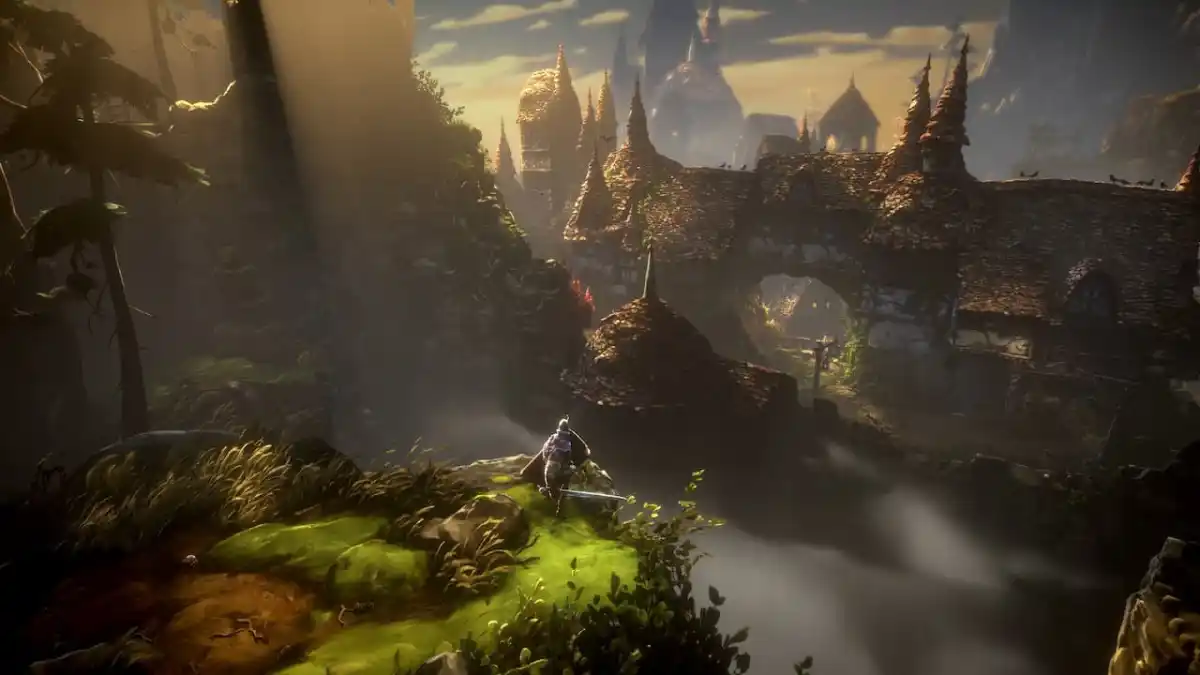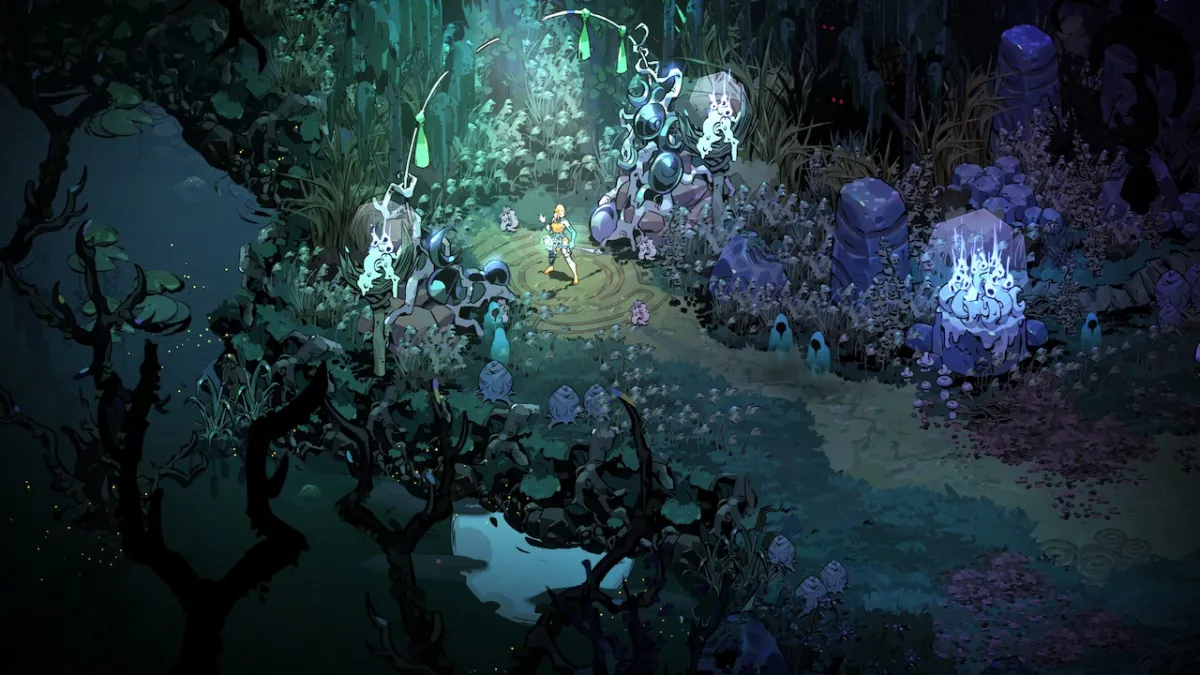To the PC users familiar with their games, Looking Glass Studios were synonymous with great design and captivating ideas. In 1992 they released Ultima Underworld – notable for being one of the first games to feature real time first-person environments, but even more notable for being a blast to play. The non-linear exploration of that title was revisited in 1998 by LGS’ Thief series, in which wry footpad Garrett had to rob and cudgel his way through a variety of mansions, tombs and … err … a trippy underground nature-god hideaway. Stealth, rather than brute force, was Thief’s hook; not-so-gently encouraging players to chill out in shadows rather than taking on swordsmen head-on. To have Thief on the CV would be a boon for any developer, but LGS followed it up the very next year with much-revered and distinctly unnerving System Shock 2. When the studio was forced to close its doors in 2000, it was no surprise that gamers felt the industry had lost a creative force.
But there was another milestone game in the LGS catalogue, which doesn’t always get the same coverage as their other stand-out titles (no, not British Open Championship Golf, although we’re sure that was amazing too.) This game featured first-person combat, vast 3D environments, tactical squad control, jump-packs and some highly entertaining Full Motion Video. It was, of course, 1996’s Terra Nova: Strike Force Centauri.
We spoke to Dan Schmidt, then project lead for Terra Nova – now lead gameplay programmer at Harmonix Music Systems, who you may just recognise as the chaps behind Guitar Hero and Rock Band – about the making of the game and the difficulties it faced in finding commercial success.
Let’s Take This Outside
TN’s plot is a futuristic musing on the themes of Imperialism. Colonists on Jupiter, locked in a stalemate struggle with Earth’s oppressive Hegemony, eventually reach agreement (with Earth funding) to shuffle off to the distant Centauri star system. The game flashes forwards 150 years to a time when the Centauri colonists have re-established an uneasy peace with Earth and now concern themselves fending off pirates and dealing with other internal troubles. This in-depth backstory is told throughout both the old-fashioned chunky manual (which is as much about establishing the feel of the gaming universe as it is about imparting knowledge of the controls) and in-game via cutscenes and information terminals. Crucially, players can learn as much or as little about Centauri history and society as they choose – if they simply want to clamber into their suit of powered armour and blow up some pirates, the tutorial serves them well.
The seemingly incongruous union of weighty, flight sim-style lists of technical weapon specifications with gameplay that is relatively easy to get to grips with can be explained by a decision taken late on in development. As Dan recalls: “It was always about squad-based combat in powered battle armor, but it was originally intended to be a more hardcore simulation. Around a year from the end of the project, we realised that it wasn’t much fun, and made the gameplay a lot friendlier.”
Contributing to that fun were the gigantic outdoor environments of TN which, at the time, offered impressive draw distances. Where other games utilised crude fog to make up for their inability to process far away objects, Looking Glass had an altogether more cunning approach: “One interesting thing was the tech we used for drawing the landscape, which at the time was amazing – you could see way farther than in any other outdoor 3D game. It was designed by James Fleming, who now works with me at Harmonix. Basically it depended on the fact that the PC’s resolution was so terrible (320×200) that when we were drawing things that were far away, we could fake them horribly, because they were only going to occupy a few pixels on screen anyway.” Not only could players ‘see’ a long way on a horizontal plane, this ingenious technology also allowed spectacular birds-eye views of the battlefields using one of the game’s most entertaining features – the jump jets. When sufficiently boosted, these could provide an almighty spring; perfect for launching a surprise aerial assault, making a quick exit, or simply for admiring the landscape from on high.
Unfortunately, the team fell slight victim to the double blow of a delayed game (although released in 1996, development on TN began in ’92-’93) and the unstoppable march of PC technology. “It certainly got delayed a lot,” says Dan “By 1996, games were starting to support “high-res” 640×400, which made the limitations of our tech apparent.” Nonetheless, TN was able to create convincing outdoor environments on a scale that could not be matched by first-person 3D contemporaries like Quake or Duke Nukem, offering a completely different gameplay experience. After all, in which other games could you opt to play as a sociopathic lumberjack and blow up all the trees?
{PAGE TITLE=Terraforming Page 2}
The Shock Of The New
There would ultimately be more trouble in store with the decision to include Full Motion Video cutscenes between missions. Dan explains the context of the decision to take the game in this direction: “It’s easy to forget now, but the early-mid-90s were sort of a weird period in videogame history. With the advent of FMV, game companies were looking to movies as a model, and Hollywood started getting interested in games but looked at them through the lens of the movie business. For a couple of years it really looked like the future of games was to be bits of gameplay interspersed with movie scenes.”
Yet the problem with FMV was always the difficulty in making it look and feel convincing with a limited budget. Games of all ages are highly stylised affairs and something about the sudden switch between the pixelated in-game adventures to real actors (or programmers with drama school experience) in expositional between-stage roles always seemed a little off. As FMV disappeared, developers flocked back to rendered sequences that could more accurately match the feel of the gameplay. Now, the actual graphics engine of a game tends to be used as the method for delivering on-the-fly cutscenes, in an attempt to make the player feel as immersed in the action as possible.
At the time of TN’s creation, though, FMV was king: “Back in that era, there was a real
FMV arms race, with Wing Commander III and IV in particular being the obvious competitors,” Dan tells us “Lots of A-list games were including more and more FMV, and it was felt by management that if Terra Nova didn’t have any it would look second-rate.” A somewhat ironic concern, given how much of the FMV would turn out. Something with which Dan agrees, “I think all the FMV of that era was pretty cheesy, and Terra Nova’s was cheesier than most! So I wince a lot looking back on it.”
Cheesy? Never …
The readme.txt for TN also contains details of a nod towards another trend of the era – the ability to play with a Virtual Reality headset. In theory the game was rather suitable for this, as it already had a visor-like field of vision on the game world. In reality, it’s unclear whether anybody ever managed to play in this fashion. Dan reveals more: “Yeah, at the time, VR was the Next Big Thing. There were a handful of companies developing helmets and shutter glasses who were all trying to get everyone to put VR support in their upcoming first-person 3D games. Like FMV, it never really went anywhere, and what ended up really moving videogames into the next generation was 3D hardware (which started getting a foothold just as Terra Nova was shipping).” Another case of unfortunate timing for the game.
{PAGE TITLE=Terraforming Page 3}
Publish And Be Damned
Although it rightfully received positive reviews on release, the decision by Looking Glass to self-publish TN proved to be a disaster. It meant LGS held all of the publication debt – a perilous situation for a title that had already been delayed and had sales in the area of 100,000. Dan expands on the knock-on effects of filming multiple scenes of FMV, which merely made this situation worse: “[the FMV] certainly cost a lot, which obviously means that we had to sell a greater number in order to break even. It was also probably a business mistake as well; it didn’t cause the game to sell great, and ended up just costing us more and delaying the game even more than it already was.”
As to why TN didn’t sell better, Dan feels that his position places him too close to the game to really analyse that. What’s clear is that the public simply didn’t take to it in the way they took to other FPS titles around at the time. This may in part have been due to the system requirements for the game, which (despite it having been delayed) were quite demanding for the era. The revolutionary open landscapes required a decent processor and at least 8Mb of memory to run. Perhaps too there was an issue with the game appearing over-complex – a hang-over from the early intentions to make it a hardcore simulation of battles inside powered armour. The range of features and tactical depth that should have attracted so many, may instead have been off-putting for some.
Those people wishing to sample TN retrospectively also face an uphill struggle. Systems have now advanced too far for the games liking and getting it to run on anything approaching a modern set-up is akin to a waking nightmare. Partly because the ‘best’ method involves using the host program DOSBox – itself something of a horror show for users. We recommend this lengthy thread on long-standing Looking Glass fansite Through The Looking Glass as probably your best bet in getting TN to run in 2009. Manage to get it going however, and you’ll be rewarded with a splendid retro gaming experience.
Return To Centauri
TN triumphed when it forged its own path. The development of technology that could draw outdoor environments at large distances (although it would be superceded) afforded the game a tremendous feeling of scale and space. When it fared less well, it was due to being caught in an era of doomed trends such as FMV and VR headsets, which not only hampered the game with additional costs, but would quickly dissipate as the Next Big Thing of PC gaming. As a result, TN stands as a paradox from an important period for PC gaming – an example of both typical Looking Glass innovation and an archival document of now-forgotten trends. In the last ever message published on their website, the LGS team wrote “We intentionally charted new game design territory … to thrive and grow the game industry must take some creative risks and continue to innovate. Although LookingGlass has fallen, we pass on the flag to those who are up to the challenge.” Precisely who owns the rights to the TN source and license is unclear, but we at IncGamers hope somebody out there can answer the call and make the sequel (or silky smooth modern remake) this excellent title deserves.


